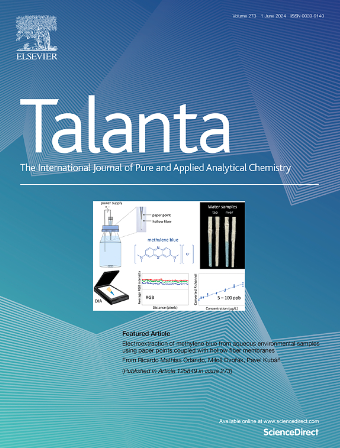Ultra-sensitive label-free DNA detection based on n-type accumulation mode vertical organic electrochemical transistors
IF 5.6
1区 化学
Q1 CHEMISTRY, ANALYTICAL
引用次数: 0
Abstract
Herein, we present an ultrasensitive DNA detection platform based on n-type accumulation-mode vertical organic electrochemical transistors (vOECTs) for the first time. The vOECTs utilize poly(benzimidazobenzophenanthroline) (BBL) as the n-type organic semiconductor channel, operating in accumulation mode with low power consumption and ultrahigh transconductance (up to 53.7 mS). DNA probes were immobilized on Au gate electrodes via Au–S bonds, followed by 6-mercapto-1-hexanol (MCH) blocking to minimize nonspecific adsorption. Target DNA hybridization induces interfacial charge redistribution and electrical double-layer (EDL) modulation, amplifying current responses through the vOECT's high transconductance. The platform achieves an exceptional sensitivity of 155.91 μA/dec—31-fold higher than state-of-the-art DNA sensors—and an ultralow detection limit of 1.07 aM. Notably, the sensor enables label-free, amplification-free detection with rapid response and excellent stability. This work establishes a novel approach for high-precision nucleic acid analysis in biomedical applications.

基于n型积累模式垂直有机电化学晶体管的超灵敏无标记DNA检测
本文首次提出了一种基于n型累积模式垂直有机电化学晶体管(vOECTs)的超灵敏DNA检测平台。vOECTs利用聚苯并咪唑苯并菲罗啉(BBL)作为n型有机半导体通道,以积累模式工作,具有低功耗和超高跨导(高达53.7 mS)。DNA探针通过Au - s键固定在Au栅极电极上,然后通过6-巯基-1-己醇(MCH)阻断以减少非特异性吸附。靶DNA杂交诱导界面电荷重新分配和电双层(EDL)调制,通过vOECT的高跨导放大电流响应。该平台实现了155.91 μA/dec的卓越灵敏度——比最先进的DNA传感器高31倍——以及1.07 aM的超低检测限。值得注意的是,该传感器能够实现无标签,无放大的检测,具有快速响应和出色的稳定性。本工作为生物医学应用中的高精度核酸分析建立了一种新的方法。
本文章由计算机程序翻译,如有差异,请以英文原文为准。
求助全文
约1分钟内获得全文
求助全文
来源期刊

Talanta
化学-分析化学
CiteScore
12.30
自引率
4.90%
发文量
861
审稿时长
29 days
期刊介绍:
Talanta provides a forum for the publication of original research papers, short communications, and critical reviews in all branches of pure and applied analytical chemistry. Papers are evaluated based on established guidelines, including the fundamental nature of the study, scientific novelty, substantial improvement or advantage over existing technology or methods, and demonstrated analytical applicability. Original research papers on fundamental studies, and on novel sensor and instrumentation developments, are encouraged. Novel or improved applications in areas such as clinical and biological chemistry, environmental analysis, geochemistry, materials science and engineering, and analytical platforms for omics development are welcome.
Analytical performance of methods should be determined, including interference and matrix effects, and methods should be validated by comparison with a standard method, or analysis of a certified reference material. Simple spiking recoveries may not be sufficient. The developed method should especially comprise information on selectivity, sensitivity, detection limits, accuracy, and reliability. However, applying official validation or robustness studies to a routine method or technique does not necessarily constitute novelty. Proper statistical treatment of the data should be provided. Relevant literature should be cited, including related publications by the authors, and authors should discuss how their proposed methodology compares with previously reported methods.
 求助内容:
求助内容: 应助结果提醒方式:
应助结果提醒方式:


